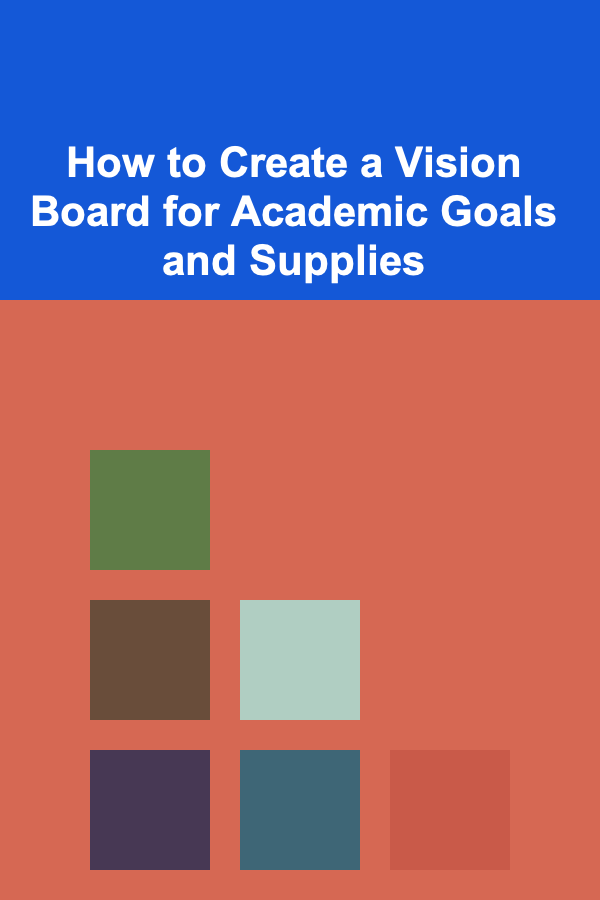
How to Create a Vision Board for Academic Goals and Supplies
ebook include PDF & Audio bundle (Micro Guide)
$12.99$8.99
Limited Time Offer! Order within the next:

Creating a vision board is an engaging and effective way to visualize your academic goals and the supplies needed to achieve them. Whether you're a student looking to boost your motivation or an educator aiming to inspire your class, a vision board can serve as a powerful tool for visualization and goal setting. This comprehensive guide will take you through the process of creating a vision board focused on academic goals and supplies, detailing its benefits, materials needed, step-by-step instructions, and tips for maintaining motivation.
Introduction
In today's fast-paced educational environment, students often feel overwhelmed by the expectations and responsibilities that come with their academic pursuits. A vision board serves as a tangible representation of your aspirations, allowing you to keep your academic goals at the forefront of your mind. By creatively visualizing what success looks like---be it specific grades, project completions, or even the supplies that facilitate learning---you can cultivate a positive mindset that drives you toward achieving those goals.
This article will explore how to create a vision board specifically tailored to academic aspirations and necessary supplies. You'll learn not only how to craft your board but also how to use it effectively throughout your academic journey.
Understanding Vision Boards
A vision board is a collage of images, words, and phrases that represent your aspirations and dreams. Typically, it serves as a motivational tool that helps individuals visualize their goals, making them more tangible and achievable.
Key Elements of a Vision Board
- Visual Representation: The primary purpose of a vision board is to provide a visual cue that keeps your goals fresh in your mind.
- Personalization: Each vision board is unique, reflecting personal aspirations, values, and desires.
- Dynamic Nature: Vision boards can evolve over time, adapting to changing goals or circumstances.
- Emotional Connection: Engaging with a vision board emotionally reinforces the desire to achieve the outlined goals.
The Benefits of Creating a Vision Board for Academic Goals
Creating a vision board for academic goals offers several advantages:
- Clarity of Purpose: A vision board helps clarify what you want to achieve academically, providing clear focus.
- Increased Motivation: Visual reminders of your aspirations can boost motivation when faced with challenges.
- Enhanced Creativity: The process of crafting a vision board promotes creative thinking, which can be beneficial in problem-solving and critical thinking tasks associated with academics.
- Positive Affirmation: Incorporating affirmations on your vision board fosters a positive mindset, reinforcing self-confidence and determination.
- Goal Tracking: Your vision board serves as a roadmap, helping you track progress towards your academic objectives.
Materials Needed for Your Vision Board
Creating a vision board doesn't require extensive resources; however, having the right materials enhances the experience. Here's what you'll need:
Basic Supplies
- Board Base: Options include corkboard, poster board, foam board, or even a digital platform (such as Pinterest).
- Scissors: For cutting out visuals and other materials.
- Glue or Tape: To affix items securely to your board.
- Markers or Pens: For writing down affirmations or notes.
- Magazines or Printed Images: Sources for visuals that represent your goals.
- Embellishments: Stickers, washi tape, or decorative elements to enhance your board's appeal.
Optional Supplies
- Colored Paper: To create backgrounds or sections.
- String and Clips: For hanging smaller items or notes.
- Digital Tools: Design software or apps if opting for a digital vision board.
Steps to Create Your Vision Board
Creating a vision board involves several steps, each crucial for the final product. Below are detailed instructions on how to create your own academic vision board.
Setting Your Academic Goals
-
Reflect on Aspirations: Take some time to think about your academic goals. Consider both short-term and long-term objectives. Examples might include:
- Achieving a specific GPA
- Completing a challenging course
- Developing study habits
-
Write Down Your Goals: Document your goals clearly and concisely. Use positive language, as this sets an empowering tone. For instance, instead of "I want to improve my grades," phrase it as "I will achieve a GPA of 3.5."
Gathering Inspiration
- Research and Explore: Look for inspiration by browsing educational websites, blogs, or social media platforms that focus on academic success.
- Find Visuals: As you explore, collect images that resonate with your goals---these could be pictures of students studying, graduation caps, or inspiring quotes.
Selecting Visuals and Affirmations
-
Choose Images Wisely: Focus on visuals that evoke emotions linked to your goals. They should resonate with your ambitions and inspire you.
-
Create Affirmations: Write down positive statements that reinforce your goals. Examples include:
- "I am capable of mastering difficult subjects."
- "My hard work pays off in academic excellence."
-
Diverse Sources: Utilize a mix of magazines, printouts, art supplies, and photographs to create a rich tapestry of visuals.
Designing Your Board
-
Arrange Your Layout: Before gluing anything down, lay out your chosen images and text on the board. Experiment with different designs until something feels right.
-
Group Similar Items: Organize your board into sections based on categories such as:
- Academic Goals
- Supplies Needed
- Inspirational Quotes
-
Secure Everything: Once satisfied with the layout, begin affixing items to the board. Be sure to leave room for future additions.
Placing Your Vision Board
- Choose a Visible Location: Place your board in a spot where you will see it frequently---ideally near your study area or bedroom wall.
- Engage with Your Board Daily: Make it a habit to glance at your vision board each day. This daily engagement reinforces your goals and keeps you motivated.
Maintaining Your Vision Board
To maximize the effectiveness of your vision board, regular maintenance is essential:
- Review Goals Periodically: Set aside time to reflect on your goals, assessing whether they still align with your aspirations.
- Update as Necessary: Add new visuals or affirmations to reflect changing priorities or achievements.
- Celebrate Milestones: Acknowledge accomplishments by marking them on the board, like adding a star for each goal achieved.
- Keep It Fresh: Occasionally refresh the design or layout to reignite excitement and creativity.
Incorporating Supplies Into Your Vision Board
As you create your vision board, consider integrating the supplies you need to achieve your academic goals:
- Visual Representation of Supplies: Cut out images of school supplies---like notebooks, pens, or tech devices---that you plan to use. Include them alongside your goals.
- Checklist of Supplies: Dedicate a section of your board to list the supplies needed for upcoming projects or courses. This serves as a visual reminder of what to procure.
- Inspirational Supply Quotes: Pair images of supplies with quotes about the importance of being prepared or organized in academics.
- Project Timelines: If you have specific projects requiring supplies, create a timeline section on your board that outlines due dates and required materials.
Conclusion
Creating a vision board for academic goals and supplies is an enriching process that can transform how you approach your studies. By visually articulating your aspirations and the tools needed to fulfill them, you establish a powerful reminder of your potential and commitment.
This interactive and personalized approach not only cultivates motivation but also fosters responsibility and accountability. With consistent engagement and periodic updates, your vision board can evolve alongside you, serving as a lifelong reference point for your academic journey. So gather your materials, unleash your creativity, and start crafting a vision board that reflects your dreams and propels you toward success!
Reading More From Our Other Websites
- [Home Budget Decorating 101] How to Create a Stylish Living Room Without Breaking the Bank
- [Organization Tip 101] Radiant Floor Heating vs. Traditional Heating: Which Is Better?
- [Home Holiday Decoration 101] How to Mix and Match Holiday Pillows and Throws to Refresh Your Existing Decor
- [Home Pet Care 101] How to Keep Your Pet's Skin Healthy and Moisturized
- [Home Holiday Decoration 101] How to Use Color Psychology in Holiday Decorating
- [Organization Tip 101] How to Choose the Right Shelving for Your Hobby Items
- [Home Soundproofing 101] How to Reduce Echo in a Room: Easy Tips to Improve Acoustics
- [Personal Care Tips 101] How to Apply Hair Serum for Smooth and Silky Hair
- [Home Family Activity 101] How to Plan a Fun and Safe Backyard Water Game for Kids
- [Personal Investment 101] 5 Profitable Deep Learning Business Ideas for Passive Income

How to Incorporate Task Lighting into Your Kitchen Design
Read More
How to Make Money Online as a Content Writer: 10 Actionable Ideas
Read More
How to Maximize Your Pantry Space with Proper Storage Solutions
Read More
How to Start a Part-Time Professional Business and Make the Most of Your Expertise
Read More
10 Tips for Communicating Security Risks to Non-Technical Stakeholders
Read More
How to Document Child Support Payments for Legal Protection
Read MoreOther Products

How to Incorporate Task Lighting into Your Kitchen Design
Read More
How to Make Money Online as a Content Writer: 10 Actionable Ideas
Read More
How to Maximize Your Pantry Space with Proper Storage Solutions
Read More
How to Start a Part-Time Professional Business and Make the Most of Your Expertise
Read More
10 Tips for Communicating Security Risks to Non-Technical Stakeholders
Read More